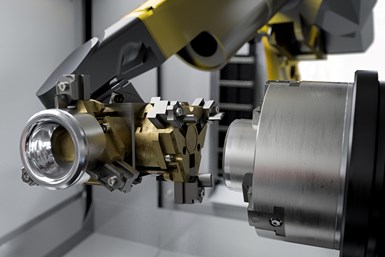United Grinding’s Studer RoboLoad Offers Seamless Part-Loading Automation
Appears in Print as: 'RoboLoad Offers Seamless Part-Loading Automation'
The machine operation requires no programming knowledge, enabling better production flexibility and a higher degree of operating comfort.
#Industry40
Edited by Angela Osborne

The Studer roboLoad operates without any programming knowledge, enabling better production flexibility and a higher degree of operating comfort. Photo Credit: United Grinding
United Grinding’s Studer RoboLoad system offers manufacturers simple, seamless part-loading automation for CNC radius internal grinding machines such as the Studer S121, S131 and S141.
The company says, until now, loader integration could be intrinsically difficult on these types of machines because of the height of their workheads and associated geometric restrictions. It is said the Studer loader not only meets the geometrical requirements but also has a comparatively small footprint. For more ease of use, it operates without any programming knowledge, enabling better production flexibility and a higher degree of operating comfort.
On the Studer S121, S131 and S141 machines, the automatic B axes swivel in a range from -60 to more than 91 degrees. The RoboLoad offers the capability to exit the machine and give the B axis the freedom to swivel.
As an external loader, the automation system measures only 59.06" (1.50 m) wide, which is half the width of the machine itself. This saves shopfloor space, while still offering ample room for workpieces, which are manually loaded on six trays — each measuring 42.52" × 12.6" (1,080 mm × 320 mm).
Operators can bring up any grinding program for the workpieces, and the RoboLoad processes them and places each workpiece back in the same place after machining. For operation simplicity, it incorporates a setup wizard developed by Wenger which requires no programming knowledge from the setter or machine operator. The easy-to-follow steps are graphically presented on a large 19'' intuitive display, the company says.
Specifications include a FANUC M10-iD 10L robot, Siemens simotion control and grippers with quick-change jaws, convertible to a single gripper for parts weighing up to 15.4 lbs (7 kg) or dual gripper for parts weighing up to 6.2 lbs (2.8 kg). Maximum workpiece size is 10.24" (260 mm) in diameter and 0.39"-3.93" (10-100 mm) in length.
RELATED CONTENT
-
Handling Parts In A Robotic Cell
Here’s a review of the workholding and workhandling challenges a shop faces as it moves a part through a robotic cell, from serving up the blanks to the transfer of the final workpiece to post processing and gaging. Productivity, Inc. takes the reader through a few of their cells that they've installed using Fanuc robots and a variety of other machine tool equipment.
-
Choosing an Automatic Bar Feeder
The bar feeder is the most common form of automation for turning operations. Selecting the right one requires consideration of the applications for which it will be used.
-
Smart Workholding Device Measures and Monitors
Sensor and IIoT technology combine to enable these chucks and mandrels to automatically monitor workholding parameters and measure part features to ensure process stability.



